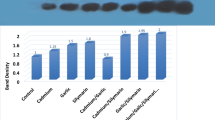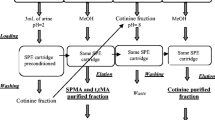Abstract
Benzene is a ubiquitous environmental pollutant primarily metabolized by a cytochrome P-450 (CYP-450) isoenzyme, CYP-450 IIE1. A consistent induction of CYP450 IIE1 has been observed in both rat and human affected by diabetes mellitus. The aim of this study was to evaluate whether streptozotocin (STZ)-induced diabetes determines modifications in the metabolic pathways of benzene in rat. Benzene (100 mg/kg per day, dissolved in corn oil) was administered i.p. once a day for 5 days. Urine samples were collected every day in STZ-treated and normoglycaemic animals, treated and untreated with benzene (n = 10). Urinary levels of trans,trans-muconic acid and of phenol, catechol and hydroquinone (free and conjugated with sulphuryl and glucuronic group) were measured by high-performance liquid chromatography (HPLC). In normoglycaemic rats during the 5 days of treatment with benzene we observed a progressive and significant decrement in the urinary excretion of phenol, phenyl sulphate and glucuronide, catechol, catechol glucuronide, hydroquinone, hydroquinone glucuronide and t,t-muconic acid (P < 0.05). In the diabetic animals, conversely, the same metabolites showed progressively increasing urinary levels (P < 0.05). Catechol sulphate and hydroquinone sulphate levels were below the instrument's detection limit. In the comparison between diabetic and normoglycaemic benzene treated rats, the inter-group difference was significant (P < 0.05) from day 3 of treatment for t,t-muconic acid, and from day 1 for free and conjugated phenol, free and glucuronide catechol and free hydroquinone. In the normoglycaemic rat exposed to benzene the decreasing trend observed in urinary excretion of free and conjugated metabolites may be due to their capability to reduce cytochromial activity. Conversely, in the diabetic rat, urinary levels of benzene metabolites tended to increase progressively, probably due to the consistent induction of CYP-450 IIE1 observed in diabetes, which would overwhelm the inhibition of this isoenzyme caused by phenolic metabolites. Furthermore, the metabolic switch towards detoxification metabolites observed after administration of high doses of benzene is not allowed in the diabetic because of reduced glutathione-S-transferase activity. As a consequence, higher levels of hydroquinone, phenol and catechol, considered the actual metabolites responsibles for benzene toxicity, will accumulate in the diabetic rat. Extrapolating these data to human, we may thus suggest that occupational exposure to benzene of a diabetic subject poses a higher risk level, as his metabolism tends to produce and accumulate higher levels of reactive benzene catabolites.
Similar content being viewed by others
Author information
Authors and Affiliations
Additional information
Received: 14 December 1998 / Accepted: 23 March 1999
Rights and permissions
About this article
Cite this article
Costa, C., Pupo, C., Viscomi, G. et al. Modifications in the metabolic pathways of benzene in streptozotocin-induced diabetic rat. Arch Toxicol 73, 301–306 (1999). https://doi.org/10.1007/s002040050622
Issue Date:
DOI: https://doi.org/10.1007/s002040050622




